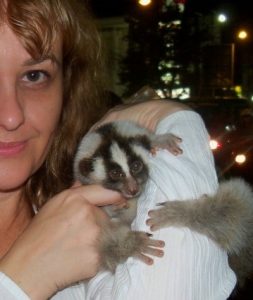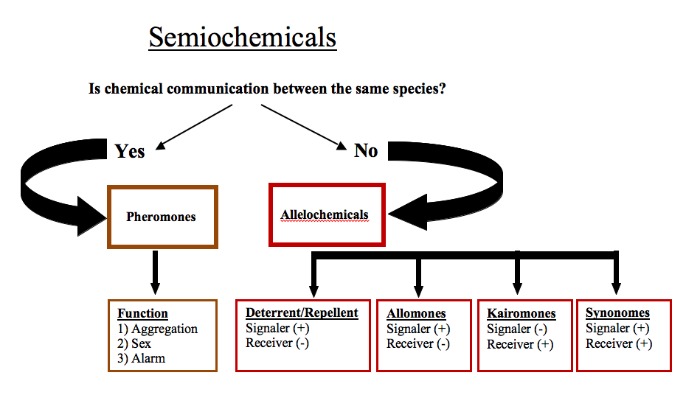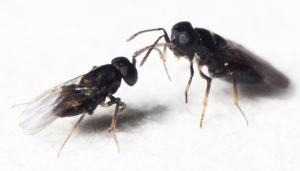I met Kelly when I gave a talk in April 2011 in Sidney BC, for the British Columbia Association of Practicing Aromatherapists . Kelly is on the BCAPA Board and is working on her PhD dissertation in Chemical Ecology at Simon Fraser University. She recently returned from Java Indonesia, where she conducted research on slow loris toxin for a BBC film.
 Robert
Robert
What is chemical ecology?
Kelly
Chemical ecology is the study of chemicals that mediate interactions between living organisms and their environment. These are known as semiochemicals. The subclass used for communication between the same species is known as pheromones. Pheromones are often classified according to their function and include sex pheromones, aggregation pheromones, and alarm pheromones (Figure 2). Many insect pheromones are also essential oil constituents; for example, linalool and geraniol are sex pheromones of the moth Spodoptera littoralis, and limonene and benzaldehyde are present in the airborne aggregation pheromone of bed bugs. (Aggregation pheromones function in mate selection, defense against predators, and overcoming host resistance by mass attack.)
Robert
What other types of semiochemicals are there?
Kelly
Semiochemicals acting between different species are known as allelochemicals, and are typically categorized contingent on the benefit(s) and cost(s) to the signaler and the receiver (see diagram). Allelochemicals that benefit the sender through deceit or propaganda are known as allomones. For example, this video shows how the female bolas spider catches male prey by mimicking various female moth sex pheromones.
Robert
That is truly one of the creepiest things I have ever seen!
Kelly
Yes, the bolas spider is totally bizarre! I gave a presentation last year on it, and the audience was completely freaked out. Generally, sex pheromone emission by female nocturnal moths peaks around midnight, but this isn’t always the case.
Robert
You were saying..
Kelly
Kairomones benefit an individual of a different species which receives it, without benefiting the emitter. For example, the aggregation pheromone of the female western bark beetle, Dendroctonus brevicomis, not only attracts males of the same species but also another beetle, Temnochila chloridia, which preys on the adult and larval bark beetles. Deterrents and repellents that are used for predator defense would also constitute allelochemicals. Plants use secondary metabolites in the form of toxins to fend off herbivores, and mammals who sequester secondary metabolites from a diet source (e.g. plants or insects), may be extremely unpalatable to consume. Essential oil constituents used by some tropical trees to deter predators are limonene and α-pinene.
The diagram shows the two semiochemical subclasses: pheromones (categorized by their function) and allelochemicals (categorized on the benefits [+] and costs [-] assigned to both signalers and receivers).
Lastly, synonomes benefit both signaler and receiver. An example of synonomes at work is pollination. Mammals and insects are attracted to many flowers or fruit-bearing plants and trees as a source of food. As a result, the pollen from flowers and seeds from fruit are dispersed which enhances reproductive success and genetic variability. It has recently been suggested that various types of flora have similarly evolved in taste and fragrance to attract human consumption and reliance on them. While thousands of types of flora perpetuate as a species because of this, we in turn benefit from their countless medicinal, therapeutic, and nutritional properties.
Robert
Is it a new field of study?
Kelly
Compared to many scientific fields, chemical ecology is not that old, and originated in the mid-to-late 1800s. During this time many significant contributions were made in the context of allelochemicals, specifically about plants producing toxins (alkaloids) that functioned as chemical defenses against predators. These ideas resurfaced in the late 1950s when scientists made similar discoveries that acted as the catalysts which put this field of study into universal motion.
Robert
How did you get involved in both aromatherapy and chemical ecology?
Kelly
My curiosity in aromatherapy heightened approximately 20 years ago when I was prescribed a cocktail of essential oils to help battle endless migraines. Their great efficacy led to my pronounced respect for aromatherapy, and it grew even more after reading your book The Art of Aromatherapy! The chemical properties of essential oils and their effects on humans fascinated me. I often wondered how or if other living organisms would similarly respond to essential oils, and what other functions chemicals served for all living organisms. As I became a certified aromatherapist, I learned that quite a few animals (e.g. horses, pigs, orangutans) mentally and/or physically benefit from essential oils. I also researched the behavioral effects of predator and non-predator olfactory cues on two slender loris species as part of my MSc thesis. Consequently, I was hooked on chemical ecology and in 2006 I decided to further my knowledge of the field by pursuing a doctoral degree. I plan on defending in Spring 2012, at which point I will be able to continue my professional practice of aromatherapy.
Robert
Tell me about your dissertation work.
Kelly
My dissertation work focuses on facets of chemical ecology, behavioral ecology, and evolutionary biology of the small solitary parasitoid wasp Ooencyrtus kuvanae. Insects are exceptional model specimens in that they demonstrate the many classes of semiochemicals. I am amazed at how advanced this 2mm insect is when it comes to chemical communication! We have strong evidence that the pheromones we’ve identified function in individual recognition and mate assessment. Other living organisms that use chemicals for individual recognition include humans, badgers, and deer – to my knowledge this has yet to be seen in any other insect.
Robert
I can understand your fascination. How did you get involved with the BBC and the slow loris toxin project?
Kelly
The loris documentary is part of a research project initiated by Dr. Anna Nekaris, a leading authority on lorises. Since she was my primary MSc supervisor, and I presently conduct research in a chemical ecology lab, the BBC sent me to the Indonesian Institute of Sciences in Bandung, Indonesia with the objective that I add to my previous knowledge of loris behavior and ecology by conducting research on the source(s) of slow loris toxin. The toxin may likely contribute to a decrease in their parasite load, a predator deterrent, and/or an alarm pheromone, all of which are critical factors to their overall well-being and survival. *As many conservation efforts are underway to stabilize populations of this endangered species, an understanding of the toxin source could prove imperative for husbandry management protocol, and possible re-release initiatives, especially if the source of the toxin comes from their diet. The Javan slow loris is endangered primarily as a result of the illegal pet trade.

One of nine slow lorises Kelly found offered for sale by a poacher on the black market in Java. (Photo by Ali Amran)
Robert
Is this a volatile toxin? Can you discuss its composition?
Kelly
The toxin likely has non-volatile and volatile properties. There is evidence that proteins play a functional role; and it is conjectured that secondary metabolites may be of equal importance.
Robert
In relation to aromatherapy as we know it, what can we learn from the world of animal / insect / plant communication?
Kelly
Much like humans, animals, insects, and plants also benefit from allelochemicals that can take the form of a warning message, a health remedy, a predator/ectoparasite repellent, and a fragrance to attract a much desired partner. What we have learned from their chemical displays have already been useful in the discovery of new medicines, the control of economic pests, and a better understanding of human courtship behavior. Since there is not one creature on this Earth that does not rely to some extent on chemical interactions, I think there are an endless number of beneficial findings we have yet to discover!




Absolutely fascinating interview, Robert, thank you for introducing me to Kelly and her work. I’ve discovered that the slow loris love to be tickled, too, much like a cat.
http://www.youtube.com/watch?v=g9f-6jygRJk
The fact that many insect pheromones are also essential oil constituents continues to call my attention. Thanks for the wonderful interview Robert!